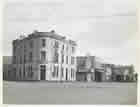After the Aboriginal word ‘jillong’, Geelong is located on a hill rising from Corio Bay and along the banks of the Barwon River. In 1802, the area figured in the early European exploration of Port Phillip, and by 1836 the first wave of settlers arrived to take up pastoral runs in the district. The expansion of the English wool industry in the early nineteenth century had created a huge demand for wool and the open plains of western Victoria promised to be fine sheep country. The township of Geelong was proclaimed in 1839 and incorporated as a town in 1849. It became an important centre for industries associated with wool and a major port for export and trade.
After the discovery of gold in Victoria in 1851, the quickest way to the diggings at Ballarat and Bendigo was by ship to Geelong, and then by road. 438 ships arrived during 1854 and while most passengers travelled onto the goldfields, some stayed in Geelong, or returned later, to open businesses.
By 1861, Geelong’s population had grown to 22,986. However, its importance and growth had been overtaken by Ballarat and Bendigo, and much of Victoria’s passenger and cargo trade bypassed Geelong’s port and went directly to Melbourne. In 1901, its numbers increased to just 25,648, but improved port facilities enabled the town to emerge from its economic trough and later prosper.



